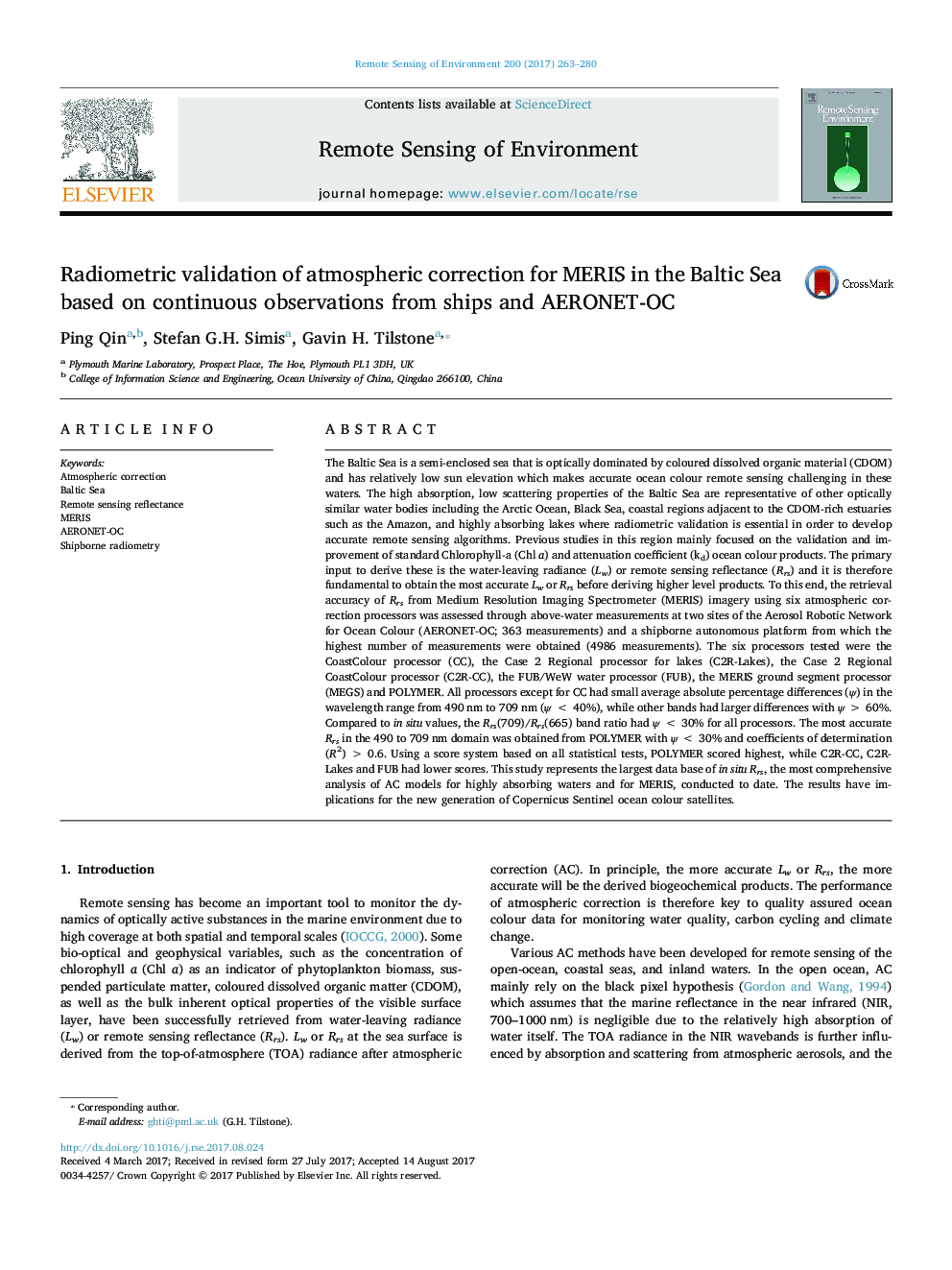| کد مقاله | کد نشریه | سال انتشار | مقاله انگلیسی | نسخه تمام متن |
|---|---|---|---|---|
| 5754735 | 1621200 | 2017 | 18 صفحه PDF | دانلود رایگان |
عنوان انگلیسی مقاله ISI
Radiometric validation of atmospheric correction for MERIS in the Baltic Sea based on continuous observations from ships and AERONET-OC
دانلود مقاله + سفارش ترجمه
دانلود مقاله ISI انگلیسی
رایگان برای ایرانیان
کلمات کلیدی
موضوعات مرتبط
مهندسی و علوم پایه
علوم زمین و سیارات
کامپیوتر در علوم زمین
پیش نمایش صفحه اول مقاله

چکیده انگلیسی
The Baltic Sea is a semi-enclosed sea that is optically dominated by coloured dissolved organic material (CDOM) and has relatively low sun elevation which makes accurate ocean colour remote sensing challenging in these waters. The high absorption, low scattering properties of the Baltic Sea are representative of other optically similar water bodies including the Arctic Ocean, Black Sea, coastal regions adjacent to the CDOM-rich estuaries such as the Amazon, and highly absorbing lakes where radiometric validation is essential in order to develop accurate remote sensing algorithms. Previous studies in this region mainly focused on the validation and improvement of standard Chlorophyll-a (Chl a) and attenuation coefficient (kd) ocean colour products. The primary input to derive these is the water-leaving radiance (Lw) or remote sensing reflectance (Rrs) and it is therefore fundamental to obtain the most accurate Lw or Rrs before deriving higher level products. To this end, the retrieval accuracy of Rrs from Medium Resolution Imaging Spectrometer (MERIS) imagery using six atmospheric correction processors was assessed through above-water measurements at two sites of the Aerosol Robotic Network for Ocean Colour (AERONET-OC; 363 measurements) and a shipborne autonomous platform from which the highest number of measurements were obtained (4986 measurements). The six processors tested were the CoastColour processor (CC), the Case 2 Regional processor for lakes (C2R-Lakes), the Case 2 Regional CoastColour processor (C2R-CC), the FUB/WeW water processor (FUB), the MERIS ground segment processor (MEGS) and POLYMER. All processors except for CC had small average absolute percentage differences (Ï) in the wavelength range from 490Â nm to 709Â nm (ÏÂ <Â 40%), while other bands had larger differences with ÏÂ >Â 60%. Compared to in situ values, the Rrs(709)/Rrs(665) band ratio had ÏÂ <Â 30% for all processors. The most accurate Rrs in the 490 to 709Â nm domain was obtained from POLYMER with ÏÂ <Â 30% and coefficients of determination (R2)Â >Â 0.6. Using a score system based on all statistical tests, POLYMER scored highest, while C2R-CC, C2R-Lakes and FUB had lower scores. This study represents the largest data base of in situ Rrs, the most comprehensive analysis of AC models for highly absorbing waters and for MERIS, conducted to date. The results have implications for the new generation of Copernicus Sentinel ocean colour satellites.
ناشر
Database: Elsevier - ScienceDirect (ساینس دایرکت)
Journal: Remote Sensing of Environment - Volume 200, October 2017, Pages 263-280
Journal: Remote Sensing of Environment - Volume 200, October 2017, Pages 263-280
نویسندگان
Ping Qin, Stefan G.H. Simis, Gavin H. Tilstone,